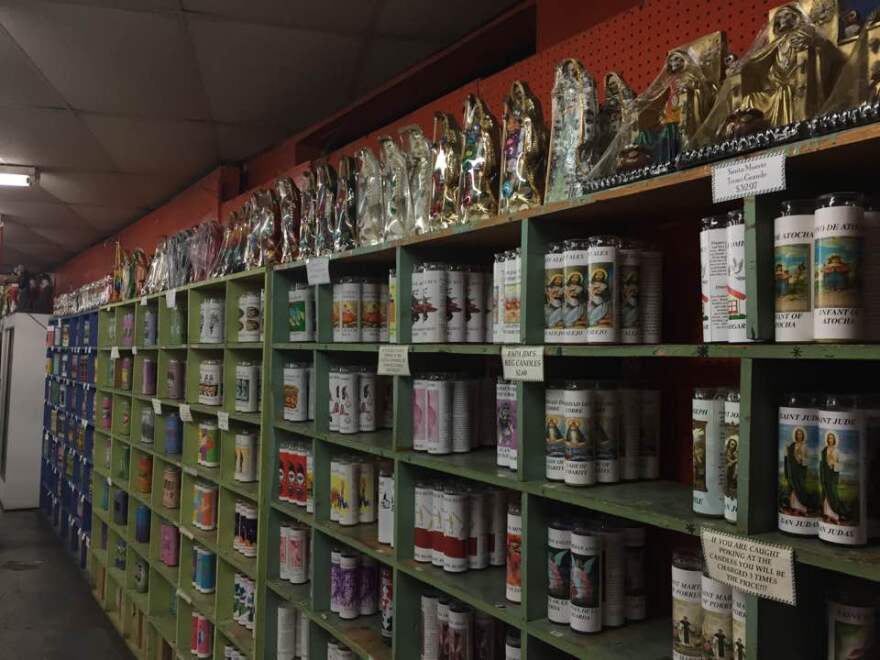There’s plenty of skeletal imagery around this week, but one bony figure showing up more in South Texas has little to do with Halloween or Dia de Los Muertos. She’s Santa Muerte, or ‘Saint Death,’ a Mexican folk saint condemned by the Catholic Church. Devotion to the skeleton saint is growing quickly—even in San Antonio.
Ana Maya’s San Antonio home is filled with images of Santa Muerte, from posters and jewelry to the several dozen statues she uses for her spiritual work.
“People know me as Brujita Maya la Santa Muerte, and I pray and devote to Santa Muerte,” Maya says.
Santa Muerte is the Mexican folk saint of death—a female grim reaper holding a scythe and globe. Catholic Church leaders have condemned ‘Our Lady of Holy Death,’ but devotion to the skeletal saint is growing—even in San Antonio.
Some of Maya’s statues could be used to ask Santa Muerte for things like protection or love. Users give her offerings in exchange.
“She likes roses, she likes bread,” says Maya. “She loves liquor—she’s an alcoholic. She loves tequila.”

Maya was raised Catholic in Mexico, but began praying to Santa Muerte 5 years ago after her brother was killed. She says she now helps hundreds more practice this mash-up of traditional Catholicism and indigenous magic.
“Santa Muerte’s not a religion, you know,” says Maya. “It’s more of a cult—something that we found. We preach to it and it works for us.”
On a recent night, Maya performs a ‘cleansing.’ A pregnant woman stands blindfolded in a circle of rose petals and eggshell powder as Maya and her husband fill the room with body spray, smoke, prayers and incantations.
Maya chants appeals to Santa Muerte as her husband, Robert Villarreal, rattles off “our fathers” is fast repetition. The ceremony seems more like an exorcism than a Catholic mass.

Afterwards, the woman—who doesn’t want to use her name—says she feels peaceful. She’s been Maya’s client for two years and is asking Santa Muerte to bring her husband back.
“I hope to improve my situation,” she says, in Spanish. “To get more money and more things, and to fix my marriage.”
More and more disaffected Catholics and spiritual seekers in San Antonio are turning to Santa Muerte for help. Just ask Yuly Ortiz, manager at Papa Jim’s Botanica.
“So all of these right here are, you know, just really good sellers,” Ortiz says—pointing to Santa Muerte statues of all colors and varieties lining and entire wall of the South Side emporium. “Within a month basis, I’ll sell maybe 40 to 50 statues overall.”

When Ortiz started here 15 years ago, there were no Santa Muertes on the shelves. Now, customers ask her about ‘the Bony Lady’ every day.

“I tell my customers when they come in here, She’s just like any other saint,’ says Ortiz. “The only difference is that if you’re going to ask for something, and you’re going to promise something, just make sure that you come through. If you don’t come through, she just comes and takes what she gave you. It’s simple.”
The leading Santa Muerte scholar in the United States, R. Andrew Chestnut at Virginia Commonwealth University, calls it the fastest growing religious movement in the Americas. He estimates between 10 and 12 million followers—mostly in Mexico.
UTSA Latin American Studies professor Malgorzata Oleszkiewicz-Peralba wrote about Santa Muerte in her 2015 book “Fierce Feminine Divinities of Eurasia and Latin America.” She says the practice is making inroads on this side of the border.
“It’s kind of a secretive devotion,” says Oleszkiewicz-Peralba. “It’s not public at all like in Mexico. That’s why you don’t see it on the street. You don’t see it in any centers of worship. Not in San Antonio, at least not yet.”
Santa Muerte is visibly popular among drug traffickers and prisoners—which contributes to the stigma—but Holy Death is gaining disciples of all stripes.
“Regular people—housewives in Mexico City and here in San Antonio are very devoted to Santa Muerte and they have nothing to do with any crime,” says Oleszkiewicz-Peralba. “So I think it’s a broad spectrum, and you cannot reduce it to any one group.”
The professor says, mostly, Santa Muerte seems to appeal to people who feel disenfranchised by the Church and other institutions.
“She’s completely unorthodox,” says Oleszkiewicz-Peralba. “There’s no control. So you can use her for anything you want, basically. And you can ask her for anything you want.”
Mexican Catholic bishops and Vatican officials have deemed the practice ‘blasphemous’ and ‘Satanic.’ Archbishop Gustavo Garcia-Siller says he first heard of Santa Muerte 15 years ago in Mexico—and he doesn’t see much of her in his San Antonio Archdiocese.
“Not acceptable in the Church at all,” he says. “We don’t pray to bones. We pray to God.”

The Archbishop says Catholics pray for their dead loved ones to be in heaven. They do not pray to the personification of death. Garcia-Siller urges the many Santa Muerte devotees who identify as Catholic to do something else with their faith.
“To put that faith in God, put that faith in the community, put that faith in one another,” says Garcia-Siller. “And not to depend on an object—something that is material and cannot promise at all something that is eternal.”
“I tried my best to find it in the Church, but it wasn’t,” says Brujita Ana Maya. So, I found Santa Muerte and she helped me.”
Maya says she’s also helped others—in ways the Church can’t.
“When you go to the Catholic Church, the priest is talking, and it’s like little robots doing the same thing,” says Maya. “Everybody talks about the same verse in the bible. And woman cannot speak. For me, I love this because I can speak, I can be head too, and I have that power.”



